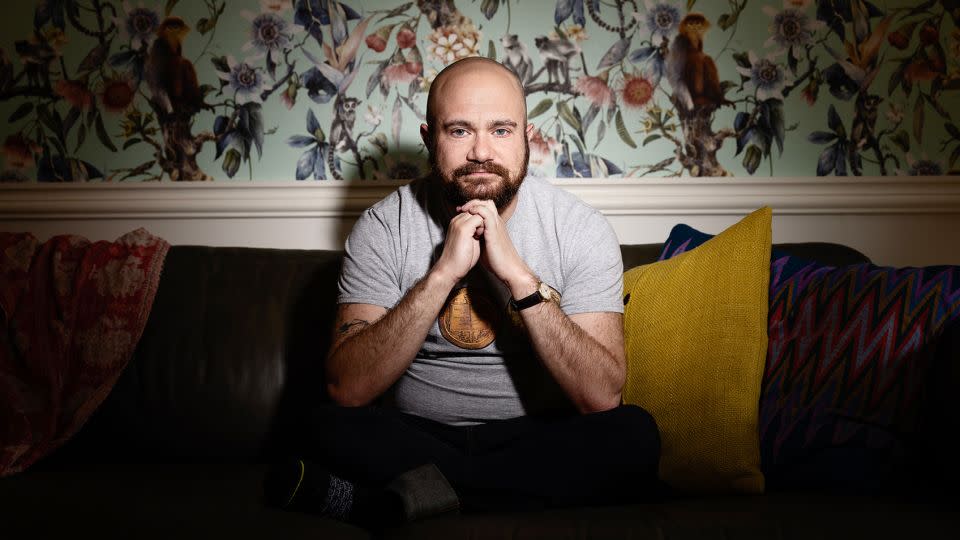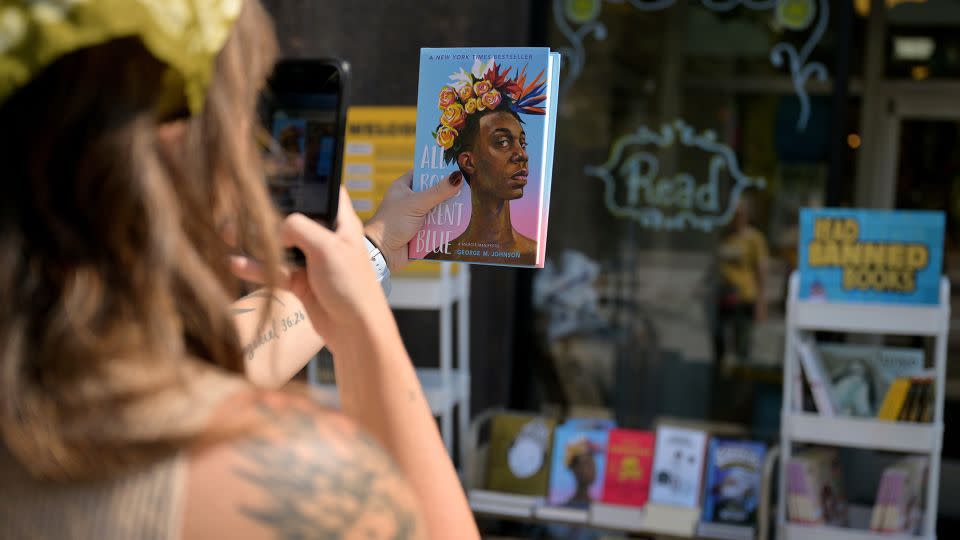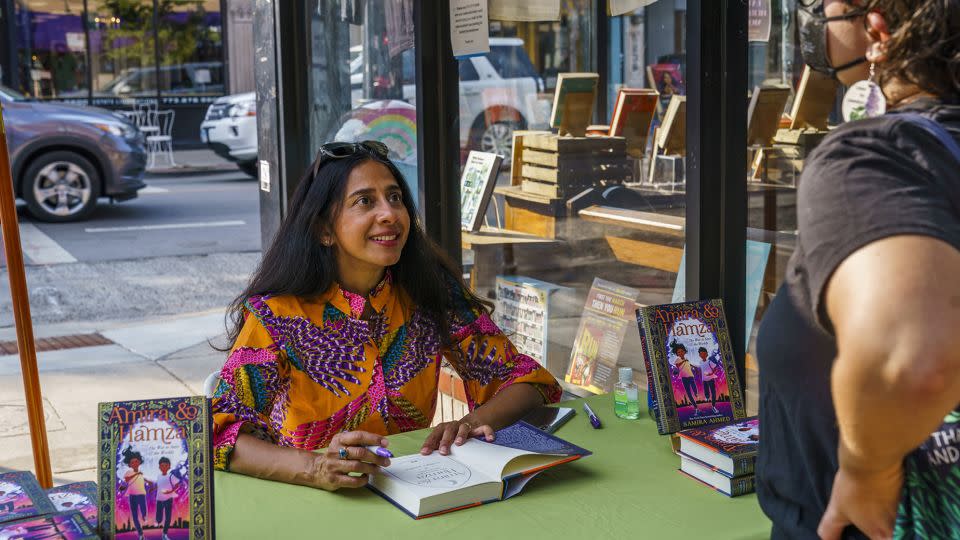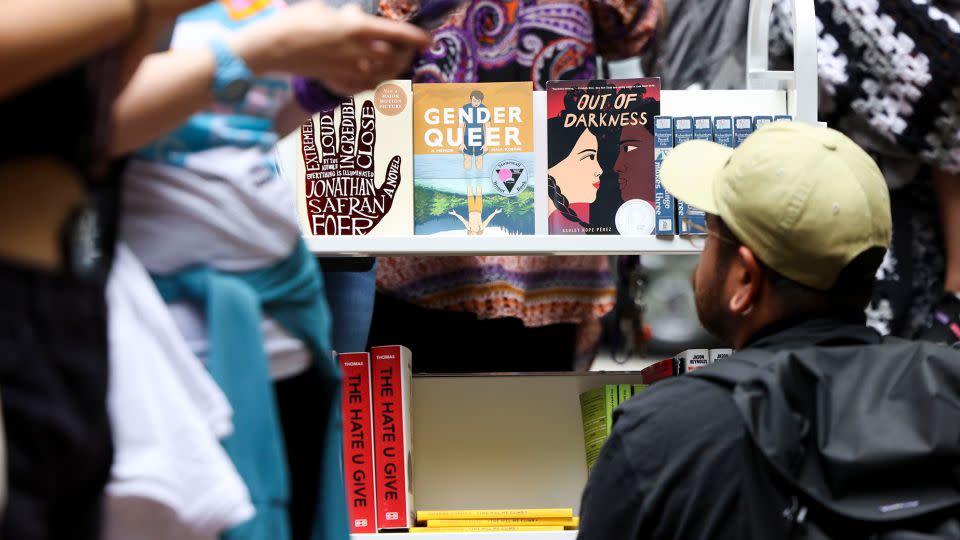Book bans are surging — and taking an emotional toll on many authors
- Oops!Something went wrong.Please try again later.
- Oops!Something went wrong.Please try again later.
In March 2022, Florida Gov. Ron DeSantis appeared onstage alongside a page from the picture book “Call Me Max,” blown up on a piece of poster board.
The page showed a child lying outside on the grass on their tummy next to a snoozing dog. The child looked contemplative, their hand propping up their cheek.
“When I was born, my mom and dad said, ‘It’s a girl!’
When I looked in the mirror, I saw a girl.
Kind of.
But because I’m transgender, I wanted to see a boy.”
DeSantis held up the page as an example of a book that wasn’t “appropriate for any place, but certainly (not) in the state of Florida.”
Minutes later, he signed Florida’s “Parental Rights in Education” bill, better known by its critics as the “Don’t Say Gay” bill, which prohibited classroom instruction about sexuality and gender identity in kindergarten through third grade. (Earlier this year, the state expanded the law to ban teaching those topics in all public schools through 12th grade.)
The bill’s passage made national headlines, enraging parents who opposed censorship and inspiring others to take up a similar cause in their children’s schools. As a result, books like “Call Me Max” have been challenged or outright removed from schools and libraries in Florida, as well as other states — and though some believe book bans lead to more book sales, authors say the effect of those bans is devastating for their careers.
Kyle Lukoff, the author of “Call Me Max” and the Newbery Honor book “Too Bright to See,” among others, said the national publicity did little to nothing to improve sales of “Max.” Instead, it introduced his work to people who want to remove it from bookshelves in their local schools and libraries.
“I’ve had this said to me many times — ‘I wish my book would get banned because that’s the best way to get it on the best-seller list,’” Lukoff said in a phone interview. “That certainly never happened for me.”

Lukoff hasn’t yet earned royalties from “Call Me Max” or the other two books in its series, he said. His advances were $2,500 per book, and he won’t earn those royalties until all of them earn the money back.
Lukoff’s experience — and the experiences of hundreds of authors whose books have been banned in the last school year — contradicts a common refrain among some authors and anti-censorship proponents that banning a book results in a sales surge.
“When books get banned, even when authors do see a spike in sales, it is much more devastating for careers in the long run,” Lukoff said. “If your book is kept out of libraries and schools in entire states — that does translate to a long-term consistent drop in sales.”
Phil Bildner, a children’s book author and advocate for fellow writers, said that “having a book banned is not a badge of honor.”
“I still don’t think most people grasp just how financially devastating this book banning era is to queer authors and authors from marginalized communities,” said Bildner, who runs the Author Village, a group that represents authors and illustrators for school visits. “And I know most people don’t grasp the emotional toll it’s having on the authors in the crosshairs.”
The current book ban movement is bigger, faster and more pervasive
Up until recently, a list of banned books was a blend of the usual suspects — “The Catcher in the Rye,” “To Kill a Mockingbird,” “The Bluest Eye” — and newer favorites like “The Hate U Give” and “Thirteen Reasons Why.”
But book bans have surged in the last year. PEN America, an organization that supports and protects First Amendment rights for writers, journalists and other communicators, reported that more than 3,300 books were banned in the 2022-2023 school year, a 33% increase from the previous school year. These bans “overwhelmingly” target books about race and racism, as well as books with LGBTQ characters, PEN America said in its September study on school book bans.
There are concentrated efforts from groups like Moms for Liberty and LaVerna in the Library, an offshoot of Utah Parents United, to ban dozens of books at once. These groups compile comprehensive lists of books that contain what these groups point to as objectionable material. Websites like Rated Books and BookLooks grade books based on their content and highlight potentially objectionable paragraphs on their sites, posting entire pages out of context.
Vocal individuals have also had immense power in banning books: The Washington Post reported in May that 60% of book challenges in the 2021-2022 school year came from just 11 people. Larger groups also share instructions for individuals on how to get books banned and what to say at school board meetings — typically, parents will read “controversial” excerpts aloud.
“When we look at books and obscenity, we have to look at the whole book,” said Tasslyn Magnusson, a program consultant with Freedom to Read at PEN America who tracks banned books and works with authors whose works have been removed from schools and libraries.

Magnusson pointed to books like “Speak,” Laurie Halse Anderson’s frequently challenged novel about a high schooler who, after being raped, works through her trauma in an art class, and George M. Johnson’s “All Boys Aren’t Blue: A Memoir-Manifesto,” which contains scenes of sexual assault. Sexual content, explicit language and disturbing content may appear in those books, but they’re appropriate in context, Magnusson said.
Deborah Caldwell-Stone, director of the American Library Association’s Office for Intellectual Freedom, said it’s within parents’ rights to choose certain books for their kids and avoid others. But “no one group, no one parent should dictate what’s available for other families,” she said.
“Everyone (deserves) the freedom to find a wide range of ideas in a library — they’re there to serve everyone in a community,” she said.
Bans can boost sales, but they often don’t
Many of the authors interviewed noted that a ban can boost sales of a book — Angie Thomas, the author of “The Hate U Give,” has said that every time that book is banned in a school district, “the sales in that area skyrocket.”
This was the case with “Maus,” Art Spiegelman’s Pulitzer Prize-winning graphic novel about the Holocaust. In January 2022, a Tennessee school board banned the title for “inappropriate words” and a partially obscured image of a nude woman. Those protesting the decision bought “Maus” in droves until it was backordered for months. It topped Amazon’s list of best sellers, and BookScan, a publishing industry tool that tracks book sales across the country, reported that sales of “Maus” jumped 753% between the first week of January to the last.
But soaring sales are not common, authors said, and it’s increasingly rare now that hundreds of books are being banned at once.
“It’s hard to explain why it works when it works, but it’s a fluke — it’s not the pattern,” Magnusson said. “The pattern is that this has a devastating impact on current and future income.”
Libraries and schools account for a massive chunk of all children’s literature sales, Magnusson said. So if libraries across a state, particularly those in states with some of the largest school districts, opt not to buy a book, that could effectively put a book out of print, Lukoff said.
BookScan and the Association of American Publishers told CNN they did not have data that was granular enough to provide insight into how book bans affect subsequent sales.
When a group or parent sets out to ban a book, they often target both well-known books and works from independent presses or authors with less name recognition. Books by lesser-known authors like Juno Dawson’s “This Book is Gay” or Mike Curato’s “Flamer” are often bundled with hits like “Speak” or John Green’s “Looking for Alaska,” both of which were adapted into films. Those less familiar works may not appear in a bookstore or library’s banned books display, said Samira Ahmed, an author who said her 2019 book “Internment” has been “soft banned,” or removed from shelves by school staff without a formal challenge.

The sheer number of banned books makes it nearly impossible for a “Maus”-like breakout. There were more than 1,400 book bans in Florida alone last school year, as PEN America reported. Building a movement to buy all of them in a show of support isn’t feasible, Lukoff said.
“(A book ban) would make news, and people would say, ‘I’ll buy this book just to show them,’” Lukoff said of the once-common result of book bans. “Now that it’s an entire movement (to ban books)… that’s not a sustainable response.”
When books for young people don’t sell well within school districts, they’re not likely to get a paperback release, Lukoff said. “Books just kind of disappear.”
Author opportunities, from school visits to future books, can dry up
Writing books for children is far from glitzy or reliable work, Magnusson said. While advance rates for picture books and middle-grade books are relatively opaque to the public, she said she’s heard from authors whose advances are a few thousand dollars — around the same as Lukoff’s were for the “Max” series — and many of those advances haven’t earned out.
“It’s not a lucrative job by any means,” she said.
Because publishing alone isn’t a guaranteed windfall, many authors who write for young people rely on school visits and other paid appearances at literary conferences or libraries to make a steady income, Magnusson said. This school year, some of those offers have been rescinded or were never proposed: Ahmed said her number of school visits have dwindled to just three this year; Bildner said several queer authors he knows are also down to three or four visits a year when they typically did 20 to 30.
“These opportunities are now virtually nonexistent,” Bildner said of paid visits, particularly for LGBTQ authors.
Being banned can also hurt an author’s future prospects. Caldwell-Stone said that publishers might be wary of buying a manuscript from an author whose works have been tagged as “controversial.”
And it might be even more difficult for lower-profile authors to weather these bans, Lukoff said, particularly without the backing of a major publishing house or the name recognition of authors like J.K. Rowling, Harper Lee or Art Spiegelman.
“Everyone knows about ‘Maus,’” he said. “It’s much harder for a random queer or trans person or a person of color whose debut has just gotten swept up in all of this.”
And it’s possible, said Caldwell-Stone, that publishers may not be as willing to offer contracts to new authors whose subjects have been deemed controversial, particularly topics like race and racism or LGBTQ life.
“There are definitely fears that now putting money into books that are likely to get banned is a losing proposition financially for publishing houses,” Lukoff said. “It makes an already hard proposition that much harder.”
Bans take an emotional toll on authors
Because the market for books about subjects like racism and LGBTQ life is uncertain, those unknowns may drive authors not to write at all, or to write something other than the subjects they’re passionate about all to ensure they can make a living, said Torrey Maldonado, author of “What Lane?” which has been cited frequently as a useful guide to antiracism for young people.
“There are authors and illustrators who think, if this is going to be blocked, maybe I should do something else, or maybe I should create something else,” Maldonado said. “Book banning threatens to stamp out people’s fire.”
“It’s taken so much work to begin to shift publishing to be more representative of who people are,” Magnusson said. “That work has been severely attacked here.”
And the parents who challenge these books at school boards have sometimes targeted the authors themselves. Ahmed said she knows several authors who’ve been “doxxed, threatened and called horrific slurs” by critics who challenge their work.

“People who specifically create a career to write for young people, they’re spending so much time thinking about their audience — ‘What did I not have to read when I was a young person?’” Magnusson said. “Children’s authors, especially, spend so much time connecting to their inner child, that to be called ‘pedophiles,’ ‘sexual deviants,’ sent hate mail — that has a psychological and emotional impact that is pretty profound.”
Ahmed said it’s a “slap in the face to see my work categorized as profane or obscene” when she writes specifically for young people.
It’s exhausting, too, for authors who didn’t plan to fight book bans regularly. Lukoff said his first high-profile bans occurred in early 2021, in Austin and Salt Lake City, when book bans first started to accelerate. The volume of bans has “only gotten worse,” he said, and it’s started to define his work.
“It is so unrelenting,” he said. “I’m not surprised that my books have been banned; I’m surprised this has become a much larger, inescapable political movement.”
Book bans hurt readers and authors
Book bans are not new, noted Maldonado. They’re a political tool of domination, he said, to silence certain voices and points of view, particularly when those points of view come from a person of color or someone who identifies as LGBTQ.
“It’s not just our work being condemned, it’s us, personally, it’s our identities,” Ahmed said. “The very real goal of book bans is to erase identities from the shelves — a campaign led by fear and hate — under the guise of ‘parental rights.’”
And the reaction to book bans could see publishers take a major step back in terms of supporting inclusive literature, Magnusson said.
“It’s taken so much work to begin to shift publishing to be more representative of who people are,” Magnusson said. “That work has been severely attacked here.”
Ultimately, those who lose the most when a book is banned are the authors who write for children and the children who may never have a chance to read those works in their schools or local libraries, said Ahmed.
“There have been thousands of challenges across America, and what that actually means is that young people are being denied the opportunity and access to these books,” she said.
For more CNN news and newsletters create an account at CNN.com

